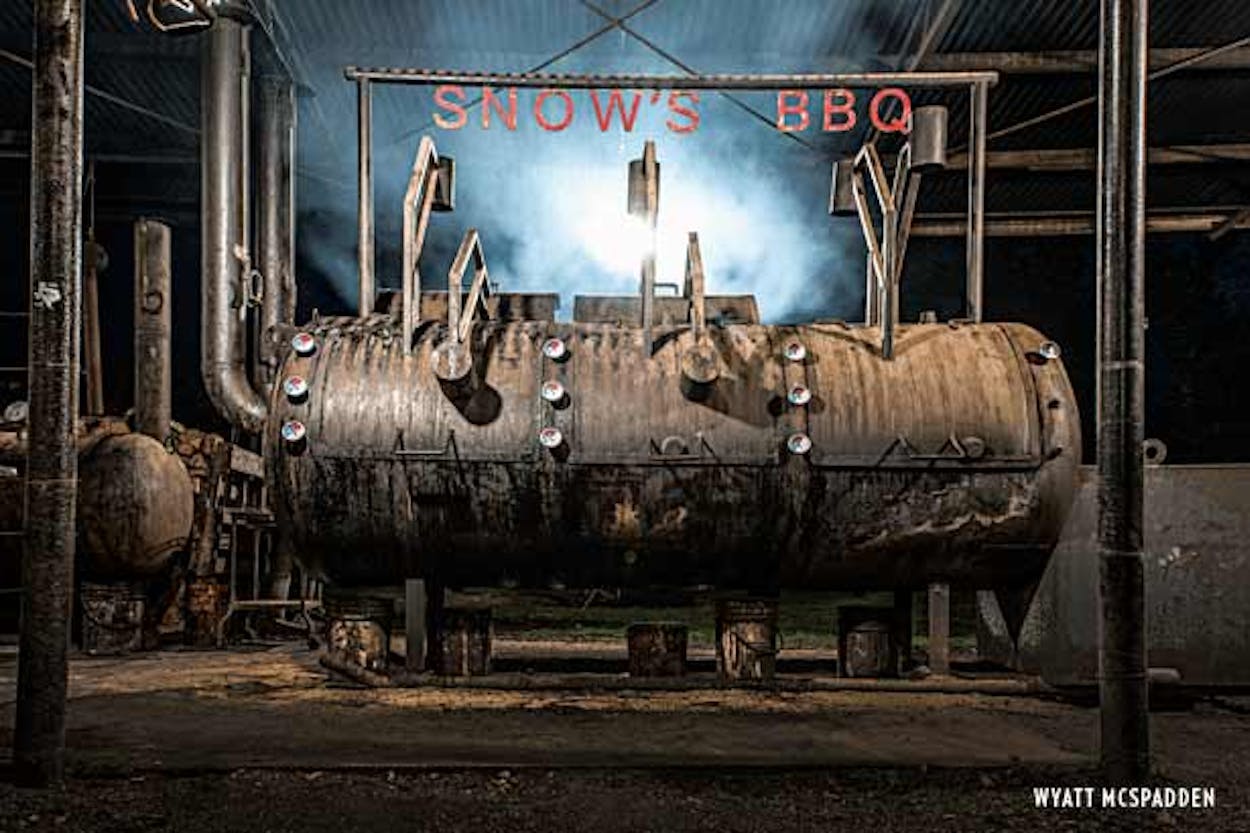THE TERM “PIT” ORIGINATED back in the days when that’s just what it was—a pit in the ground, with wood coals inside and a grill made of wood or metal. Most people cooking with direct heat nowadays use an above-ground fire, but the method is essentially unchanged. It works well for a fatty meat like pork. During cooking, fat will drip into the fire, causing flare-ups that singe the meat and create delicious, crusty edges. The downside of direct heat is that it cooks fast; a less fatty meat can come out tough. In Texas the indirect-heat pit, sometimes called an offset smoker, is king, since it’s best for cooking brisket, which requires many hours of low, smoky heat to achieve perfection. (A smoker, by the way, may be called a pit, but a direct-heat pit, for obvious reasons, may never be called a smoker.) Texans excel at so many meats, however, that our equipment comprises a wide variety of hardware. Here are a few pits you may recognize.
Steel Offset Smoker: This type of smoker has three main elements: a large chamber to hold the meat, a firebox, and a smokestack or two. The smokestack draws air, smoke, and heat from the firebox through the chamber, cooking the meat in the gentlest manner imaginable. The challenge of an offset smoker is properly maintaining your fire and resisting the urge to open the lid every ten minutes and check your meat.
Brick Offset Smoker: The function here is identical to a steel offset smoker, but the firebox is more wide-open and the chamber itself is made of brick rather than steel, allowing it to more efficiently retain heat. The most famous brick smoker in the state is probably the one at historic Smitty’s Market, in Lockhart, where the fire sits on the floor. (Watch your step!)
Bewley Pit: A steel offset smoker manufactured by A. N. Bewley Fabricators, in Dallas, the Bewley’s signature feature is an electronic damper that automatically opens and closes to regulate oxygen flow and keep the fire at an optimal temperature. Inside the smoking chamber is a series of shelves that can be moved around manually based on what kind of meat is loaded in.
Oyler Pit: Another steel offset smoker, the Oyler is made in Mesquite by J&R Manufacturing. It has revolving shelves that can be loaded down with meat and rotated like a barbecue Ferris wheel. But don’t be fooled: although it plugs into the wall, that’s just to power the rotisserie. The Oyler is fueled by a firebox that uses only
wood, no gas.
Direct-Heat Steel Pit: Wood is burned down to coals, which are then transferred to a steel boxlike structure and spread evenly beneath metal grates. Meat is cooked directly over the coals, which makes for a less smoky taste, but when the fat drips into the fire, the flames surge and the meat gets those delicious crusty edges.
Gas-Fired Rotisserie: Companies like Southern Pride and Ole Hickory have taken the basic elements (rotisserie, firebox) of a wood-fired Oyler smoker and added gas and electric lines and a mess of stainless steel. This type of smoker is considered by many to be inferior to an all-wood smoker since it uses gas burners to regulate the heat. While wood is usually loaded into the firebox, it can also function as a gas oven if the wood is either left out or has already burned away, which makes it tough to actually smoke the meat. Good barbecue can be done in one of these “gassers” if the pitmaster is generous enough with his wood and pays attention to his fire, but the gas-fired smoker is best known for enabling the set-it-and-forget-it cooking style that rarely yields a quality product. On the plus side, it does allow some aging pitmasters to continue working who could not otherwise deal with the grueling schedule required for wood-burning pits. Think of it as the designated hitter of the barbecue world.
(This story originally appeared in the June 2013 issue of Texas Monthly.)








